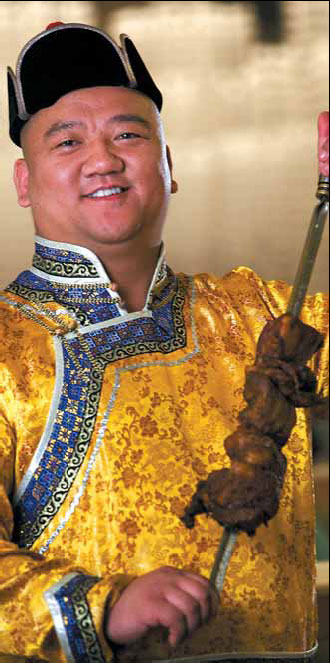Shangri-La on the Mongolian grasslands
Updated: 2012-07-14 07:59
By Zhang Zhao (China Daily)
|
||||||||
|
The two Shangri-La hotels on the grasslands serve Mongolian delicacies. Photos provided to China Daily |
Hotel profile | Inner Mongolia
Zhang Zhao discovers that the famed luxury hotel chain brings top service and amenities to the land of horses, yurts and deer.
Following the publication of James Hilton's popular novel Lost Horizon in 1933, Shangri-La has become synonymous with great natural beauty and serenity.
The hotel chain named after the legendary land has replicated that sense of well-being to become renowned worldwide.
And when the modern luxury of the Shangri-La Hotels meets Mongolian grassland culture, the result shines with ethnic sparkle.
In 2007, two Shangri-La Hotels were opened in the Inner Mongolia autonomous region - one in the capital city Hohhot and the other in the industrial city Baotou. Combining local features with high-quality facilities and services, they are now among the cities' most luxurious and best-equipped hotels.
Both hotels target high-end business travelers, share similar architecture and have prime locations in the center of their respective cities.
The Baotou Shangri-La sits beside a botanical garden that covers 90 hectares and a large square called Wanda Plaza.
The plaza and hotel were once a place for deer - the city's name in Mongolian language, Baoktu, literally means "a place where deer live".
After the hotel was built in 2007, the deer were moved to Saihan Tal, the only grassland inside an urban area in China.
All Chinese restaurants in the Shangri-La Hotels across the world are called Shang Palace, but in Hohhot and Baotou, more local features have been added. In Baotou, for example, there are three Mongolian-style dining rooms named Genghis Khan, Kublai Khan and Baoktu.
The hotels' interiors also carry hints of local characteristics with Mongolian paintings in the lobbies, corridors and guestrooms. In Baotou, the Shangri-La has statues of deer.
The hotels offer buffet restaurants and cuisines from around the world, including Western-style steak, Chinese dishes and Japanese sushi and sashimi, just like Shangri-La Hotels anywhere else. But there is again a nod to Mongolia, with local food such as milk tea, dried beef and fried millet on offer.
At the Huhhot Shangri-La, guests can try making noodles in the traditional way with a local wooden mold.
The hotel also employs a chef from Hong Kong who is good at innovative cuisine. One of his creations is fried rice with soup and seafood. He calls it "thunder fried rice" due to the cracking sound the rice makes when soup is poured over it.
Another highlight is a cocktail made of many fruits and kumiss, a typical Mongolian drink combining alcohol and horse milk.
The hotel is promoting a grassland-themed tour program that lasts from June to September. Guests are invited to stay in Mongolian yurts in the Gegentala Grasslands, 140 kilometers north of Hohhot. There, visitors can enjoy both the best views of the landscape and quality Shangri-La services.
"The program offers a safe and convenient choice for high-end customers and increases the reputation of the city of Hohhot as a tourism destination," says Victor Ng, general manager of Huhhot Shangri-La. "We provide one-stop service, which is one of our characteristics."
Contact the writer at zhangzhao@chinadaily.com.cn.

 'Taken 2' grabs movie box office crown
'Taken 2' grabs movie box office crown
 Rihanna's 'Diamonds' tops UK pop chart
Rihanna's 'Diamonds' tops UK pop chart
 Fans get look at vintage Rolling Stones
Fans get look at vintage Rolling Stones
 Celebrities attend Power of Women event
Celebrities attend Power of Women event
 Ang Lee breaks 'every rule' to make unlikely new Life of Pi film
Ang Lee breaks 'every rule' to make unlikely new Life of Pi film
 Rihanna almost thrown out of nightclub
Rihanna almost thrown out of nightclub
 'Dark Knight' wins weekend box office
'Dark Knight' wins weekend box office
 'Total Recall' stars gather in Beverly Hills
'Total Recall' stars gather in Beverly Hills
Most Viewed
Editor's Picks

|

|

|

|

|

|
Today's Top News
Health new priority for quake zone
Xi meets US top military officer
Japan's boats driven out of Diaoyu
China mulls online shopping legislation
Bird flu death toll rises to 22
Putin appoints new ambassador to China
Japanese ships blocked from Diaoyu Islands
Inspired by Guan, more Chinese pick up golf
US Weekly

|

|








